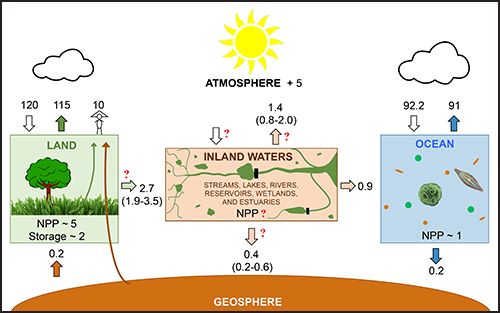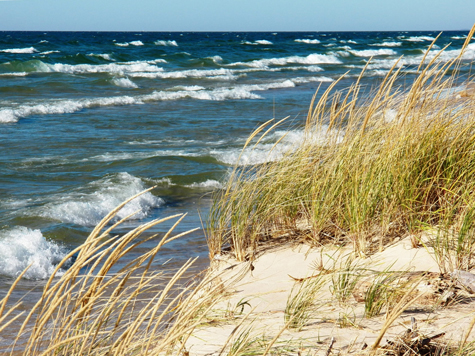As human activities continue to pump carbon into the atmosphere, the backbone of our understanding of the resulting warming is our knowledge of where that carbon is going: into the atmosphere, into the land, and into bodies of water. When it comes to accounting for the carbon absorbed and emitted by water, the role of inland freshwater may appear quite small compared to the vastness of Earth’s oceans. After all, inland lakes, rivers, streams, reservoirs, wetlands, and estuaries cover less than 4% of Earth’s surface [Downing, 2010; Verpoorter et al., 2014].
But recent research shows that the roughly 200 million bodies of inland water play a much larger role in the global carbon cycle than their small footprint suggests. Inland streams and rivers move vast amounts of carbon from the land to the ocean, acting as carbon’s busy transit system. They also play a disproportionately large role in the global carbon cycle through their high rates of carbon respiration and sequestration [Cole et al., 2007; Tranvik et al., 2009].
The amount of carbon that inland waters emit is comparable to the net amount of carbon absorbed by living organisms on Earth’s land surface and in its oceans.
According to recent estimates, the amount of carbon that inland waters emit is comparable to the net amount of carbon absorbed by living organisms on Earth’s land surface and in its oceans. Moreover, bodies of freshwater bury more carbon in sediments each year than the vast ocean floor [Battin et al., 2009; Aufdenkampe et al., 2011].
Nevertheless, there is great uncertainty in these figures, and scant data exist on continental and global scales. The changing climate is putting freshwater ecosystems at great risk: They are warming at an alarming rate, outpacing warming of the atmosphere and oceans. It’s crucial that scientists dedicate more resources to understanding the global impact of the freshwater continuum on the carbon cycle.
Emerging Role of Freshwater in the Global Theater
The latest models of the carbon cycle in land, ocean, and atmosphere show that the biosphere exchanges more than 400 billion metric tons of carbon every year: The land and oceans absorb 212 billion metric tons of carbon, and they release 206 billion tons [Schlesinger and Bernhardt, 2013] each year. Human activities emit around 10 billion metric tons of carbon, of which about half accumulates in the atmosphere each year. The other half is absorbed by the land and the ocean, 80% of which is accounted for, but the rest is still unknown (Figure 1).

The biggest absorbers of carbon are terrestrial (land-based) ecosystems. Each year, they take up roughly 120 billion metric tons of carbon dioxide (CO2) from the atmosphere and release back only 115 billion metric tons to the atmosphere. The net balance of 5 billion metric tons is known as net primary production (NPP), and it represents carbon that is removed from the atmosphere. The oceanic ecosystem NPP is about 1 billion metric tons per year. The large net terrestrial carbon sink, together with the slightly smaller oceanic sink, helps mitigate the buildup of anthropogenic CO2 from fossil fuel and biomass burning.
But the carbon absorbed by the land doesn’t necessarily stay there. Recent global estimates suggest that more than half of that carbon every year winds up in inland waters, roughly 2.7 billion metric tons. This area is where inland waters play a key role, with both positive and negative effects. Half of the carbon is respired and returned to the atmosphere as CO2—enough to wipe out the helpful effects of the oceanic sink and on the same order of magnitude as the terrestrial sink [Bastviken et al., 2011; Raymond et al., 2013]. On the other hand, roughly 0.4 billion tons get buried in freshwater sediments. Although this is a much smaller fraction, it amounts to more than all the carbon burial in oceanic sediments [Battin et al., 2009; Aufdenkampe et al., 2011]. The remaining carbon (roughly 0.9 billion tons) is exported to the oceans.
The carbon absorbed by the land doesn’t necessarily stay there.
The global importance of the freshwater carbon cycle has been recognized for some time now [Cole et al., 2007], but scientists rarely identify it separately in diagrams of the global carbon budget. Moreover, the freshwater carbon cycle is usually lumped in with that of the land. Recent textbooks on global biogeochemistry completely overlook the revised role of inland waters in the global carbon cycle [Schlesinger and Bernhardt, 2013].
As a result, we lack adequate data and proper models to evaluate how global warming will affect the ways that freshwater interacts with the land, atmosphere, and oceans. Among these key uncertainties is our understanding of carbon transformations (e.g., NPP, respiration, and storage) taking place in inland waters [Biddanda and Koopmans, 2016].
What We Know and Don’t Know About Freshwater’s Role
Fortunately, our understanding of the carbon cycle in inland waters has improved since several recent studies have highlighted the issue. In 2013, for the first time, the report from the Intergovernmental Panel on Climate Change contained a brief description of the highly reactive freshwater ecosystems and included conservative estimates of carbon emission and burial. However, much uncertainty still remains in those estimates for inland waters in general (Figure 1). Especially uncertain is how much human activity—like land use changes and runoff pollution of fertilizers into freshwater ecosystems—changes the carbon emission and storage process [Regnier et al., 2013].

In general, because rivers and streams import CO2 from soils and groundwater in their watershed, they emit substantially more CO2 than lakes do [Raymond et al., 2013]. Furthermore, there is particular concern that climate-sensitive northern lakes and streams are emitting more carbon in response to thawing permafrost and changing hydrology that frees up the movement of carbon from the land [Leach et al., 2016].
Mounting evidence also indicates that agriculture and urbanization-driven pollution are playing an important role. Fertilizers induce algae blooms and plant growth that takes up carbon. This uptake decreases the amount of carbon emitted into the atmosphere and increases carbon sequestration in inland and coastal waters [Pacheco et al., 2013; Weinke et al., 2014]. However, as these organisms decay, the process of eutrophication depletes the supply of oxygen above lake beds and riverbeds, which increases the activity of anaerobic microbes that produce greenhouse gases such as methane [Bastviken et al., 2011; Campeau and del Giorgio, 2014; Borges et al., 2015].
Furthermore, the world’s reservoirs—an exclusively human construct over the last century or so—are now estimated to collectively bury as much carbon and generate as much methane as the rest of the freshwater ecosystems combined [Clow et al., 2015].
Last, there is justifiable concern that current models don’t adequately account for the role of small ponds and streams, which store and transform relatively more carbon per unit area than larger bodies of water [Hotchkiss et al., 2015; Holgerson and Raymond, 2016].
Freshwater Continuum in a Warming World
In recent decades, the surface waters of lakes all across the world have been warming at an alarming rate of 0.3°C per decade [O’Reilly et al., 2015]. In a CO2-rich world with a growing human population, the rising heat and per capita water use are placing freshwater ecosystems under increasing stress.
How this will affect the global carbon cycle—and climate change writ large—is still uncertain. Higher temperatures will likely intensify the microbial respiration of carbon, which will increase CO2 emissions. However, ongoing eutrophication and warming of water bodies around the world may also lead to increased phytoplankton blooms, which would sequester additional carbon.
Scientists must coordinate international studies to reduce uncertainty in estimates of carbon emissions from and sequestration in freshwater ecosystems.
Because of their newly recognized role as a globally significant processor of carbon, the world’s inland waters and what happens in them will play a critical role in the biosphere’s feedback on future climate. However, despite the importance of inland waters as pivotal regulators of the global carbon cycle and as sensitive sentinels of environmental change, very few comprehensive studies of carbon flux among the variety of freshwater ecosystems on continental to global scales exist—and even those are limited [Regnier et al., 2013].
Scientists must coordinate international studies to address the challenge of reducing uncertainty in estimates of carbon emissions from and sequestration in freshwater ecosystems. One way they can do this is by quantifying the rapidly changing carbon cycle among the 100–300 million inland freshwater bodies that bridge Earth’s land-ocean continuum.
Acknowledgments
This opinion piece was inspired by discussions with Dirk Koopmans, Anthony Weinke (Annis Water Resources Institute, Grand Valley State University), and Deborah Dila (School of Freshwater Sciences, University of Wisconsin–Milwaukee) and was supported by grants from the NASA Michigan Space Grant Consortium, the National Science Foundation’s Geobiology Program, and the National Oceanic and Atmospheric Administration–University of Michigan Cooperative Institute for Limnology and Ecosystems Research.
References
Aufdenkampe, A., et al. (2011), Riverine coupling of biogeochemical cycles between land, oceans, and atmosphere, Front. Ecol. Environ., 9, 53–60, https://doi.org/10.1890/100014.
Bastviken, D., et al. (2011), Freshwater methane emissions offset the continental carbon sink, Science, 331, 50, https://doi.org/10.1126/science.1196808.
Battin, T., et al. (2009), The boundless carbon cycle, Nat. Geosci., 2, 598–600, https://doi.org/10.1038/ngeo618.
Biddanda, B., and D. Koopmans (2016), Freshwater furnace: Global significance of the changing freshwater carbon cycle, InterChange Newsl., 23(1), https://www.gvsu.edu/rmsc/interchange/z2016-february-connections-1104.htm.
Borges, A., et al. (2015), Globally significant greenhouse-gas emissions from African inland waters, Nat. Geosci., 8, 637–642, https://doi.org/10.1038/ngeo2486.
Campeau, A., and P. del Giorgio (2014), Patterns of CH4 and CO2 concentrations across boreal rivers: Major drivers and implications for fluvial greenhouse emissions under climate change scenarios, Global Change Biol., 20, 1075–1088, https://doi.org/10.1111/gcb.12479.
Clow, D., et al. (2015), Organic carbon burial in lakes and reservoirs of the conterminous United States, Environ. Sci. Technol., 49, 7614–7622, https://doi.org/10.1021/acs.est.5b00373.
Cole, J., et al. (2007), Plumbing the global carbon cycle: Integrating inland waters into the terrestrial carbon budget, Ecosystems, 10, 172–185, https://doi.org/10.1007/s10021-006-9013-8.
Downing, J. (2010), Emerging global role of small lakes and ponds: Little things mean a lot, Limnetica, 29, 9–24.
Holgerson, M., and P. Raymond (2016), Large contribution to inland water CO2 and CH4 emissions from very small ponds, Nat. Geosci., 9, 222–226, https://doi.org/10.1038/ngeo2654.
Hotchkiss, E., et al. (2015), Sources of and processes controlling CO2 emissions change with the size of streams and rivers, Nat. Geosci., 8, 696–699, https://doi.org/10.1038/ngeo2507.
Leach, J., et al. (2016), Twelve year interannual and seasonal variability of stream carbon export from a boreal peatland catchment, J. Geophys. Res. Biogeosci., 121, 1851–1866, https://doi.org/10.1002/2016JG003357.
O’Reilly, C., et al. (2015), Rapid and highly variable warming of lake surface waters around the globe, Geophys. Res. Lett., 42, 10,773–10,781, https://doi.org/10.1002/2015GL066235.
Pacheco, F., F. Roland, and J. Downing (2013), Eutrophication reverses whole-lake carbon budgets, Inland Waters, 4, 41–48, https://doi.org/10.5268/IW-4.1.614.
Raymond, P., et al. (2013), Global carbon dioxide emissions from inland waters, Nature, 503, 355–359, https://doi.org/10.1038/nature12760.
Regnier, P., et al. (2013), Anthropogenic perturbations of the carbon fluxes from land to ocean, Nature, 6, 597–607, https://doi.org/10.1038/ngeo1830.
Schlesinger, W., and E. Bernhardt (2013), Biogeochemistry: An Analysis of Global Change, 672 pp., Academic Press, https://doi.org/10.1093/obo/9780199830060-0111.
Tranvik, L., et al. (2009), Lakes and reservoirs as regulators of carbon cycling and climate, Limnol. Oceanogr., 54, 2298–2314, https://doi.org/10.4319/lo.2009.54.6_part_2.2298.
Verpoorter, C., et al. (2014), A global inventory of lakes based on high-resolution satellite imagery, Geophys. Res. Lett., 41, 6396–6402, https://doi.org/10.1002/2014GL060641.
Weinke, A., et al. (2014), Systematically variable planktonic carbon metabolism along a land-to-lake gradient in a Great Lakes coastal zone, J. Plankton Res., 36, 1528–1542, https://doi.org/10.1093/plankt/fbu066.
—Bopaiah A. Biddanda (email: [email protected]), Annis Water Resources Institute, Grand Valley State University, Muskegon, Mich.
Citation:
Biddanda, B. A. (2017), Global significance of the changing freshwater carbon cycle, Eos, 98, https://doi.org/10.1029/2017EO069751. Published on 21 March 2017.
Text © 2017. The authors. CC BY 3.0
Except where otherwise noted, images are subject to copyright. Any reuse without express permission from the copyright owner is prohibited.

